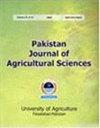氮磷缺乏土壤中对植物有益的细菌接种剂对普通豆类生长和生产力的影响
IF 0.6
4区 农林科学
Q3 AGRICULTURE, MULTIDISCIPLINARY
引用次数: 3
摘要
大多数土壤缺乏氮和磷,需要大量施用化肥以确保最佳作物产量。然而,这种做法在大多数情况下会造成严重的环境问题。近年来,接种有益菌已成为一种安全、可持续的化肥替代品。在此背景下,我们研究了两种共生放射农杆菌菌株(LMR670和LMR676)和两种促进植物生长的根瘤菌芽孢杆菌sp. (M131)和肠杆菌sp. (P1S6)作为单独或联合接种剂,在缺氮和缺磷条件下对普通豆类生长和产量的影响。在温室低磷低氮土壤条件下,评价了农杆菌菌株与普通豆的共生效率。菌株LMR670的根瘤数最高(每株53个),茎干重最高(每株0.553 g)。然后将该菌株与PGP根瘤菌联合在足磷和缺磷水平(添加80 kg ha-1磷和No P)下进行普通豆共接种试验。LMR670单次接种的茎干重最高(比未施肥对照增加82%),而组合接种的茎干重最高(增加46-47%)。为了证实所获得的结果,采用相同的处理进行了田间试验。LMR670作为单一接种剂或与M131混合接种均有效,使普通豆的产量与施氮和磷肥的植株相当(分别为13.07 t hm -1和12.35 t hm -1)。此外,单次接种多pgp菌株M131对普通大豆的所有生长参数和产量值(14 t ha-1)均有积极影响;甚至超过施用氮磷肥的对照植株。综上所述,菌株LMR670和M131可作为普通豆栽培中替代磷肥和氮肥的有效生物肥料。在全球范围内,我们的研究结果突出了本地有益植物菌株在缺氮和缺磷条件下成功结瘤、生长和产量的潜力。本文章由计算机程序翻译,如有差异,请以英文原文为准。
Phytobeneficial bacterial inoculants for common bean growth and productivity in nitrogen and phosphorus deficient soils
Most of the soils are N and P-deficient and require high applications of chemical fertilizers to ensure optimal crop production. However, this practice poses in most cases serious environmental issues. In recent years, inoculation with beneficial bacteria has emerged as a safe and sustainable alternative to chemical fertilizers. In this context, we investigated the effect of two symbiotic Agrobacterium radiobacter strains (LMR670 and LMR676) and two plant growth-promoting rhizobacteria Bacillus sp. (M131) and Enterobacter sp. (P1S6), as single or combined inoculants, on common bean growth and yield under N and P-deficient conditions. In a first trial, Agrobacterium strains’ symbiotic efficiency with common bean was evaluated in a low phosphorus and nitrogen soil under greenhouse conditions. Strain LMR670 recorded the highest nodules number (53 nodules per plant) and shoot dry weight (0.553 g plant-1). This strain was then used in combination with the PGP rhizobacteria in a common bean co-inoculation assay under sufficient and deficient P levels (80 kg ha-1of P and No P added). Single inoculation with LMR670 recorded the highest shoot dry weight (82% increase compared to non-fertilized control) compared to combined inoculants (46-47% increase). To corroborate the obtained results, a field experiment was conducted using the same treatments. LMR670 as a single inoculant or mixed with M131 was consistently effective leading to common bean yields comparable to N and P fertilized plants (13.07 t ha-1 and 12.35 t ha-1 respectively). In addition, single inoculation with the multi-PGP strain M131 showed positive effects on all common bean growth parameters and yield value (14 t ha-1); exceeding even N and P fertilized control plants. These results suggest that the strains LMR670 and M131 can be used, in a single or combined inoculation, as effective biological fertilizers for common bean cultivation to replace phosphorus and nitrogen fertilizers. Globally our results highlight the potential of native phytobeneficial strains for successful nodulation, growth and yield of common bean under N and P-deficient conditions.
求助全文
通过发布文献求助,成功后即可免费获取论文全文。
去求助
来源期刊

Pakistan Journal of Agricultural Sciences
AGRICULTURE, MULTIDISCIPLINARY-
CiteScore
1.80
自引率
25.00%
发文量
18
审稿时长
6-12 weeks
期刊介绍:
Pakistan Journal of Agricultural Sciences is published in English four times a year. The journal publishes original articles on all aspects of agriculture and allied fields.
 求助内容:
求助内容: 应助结果提醒方式:
应助结果提醒方式:


